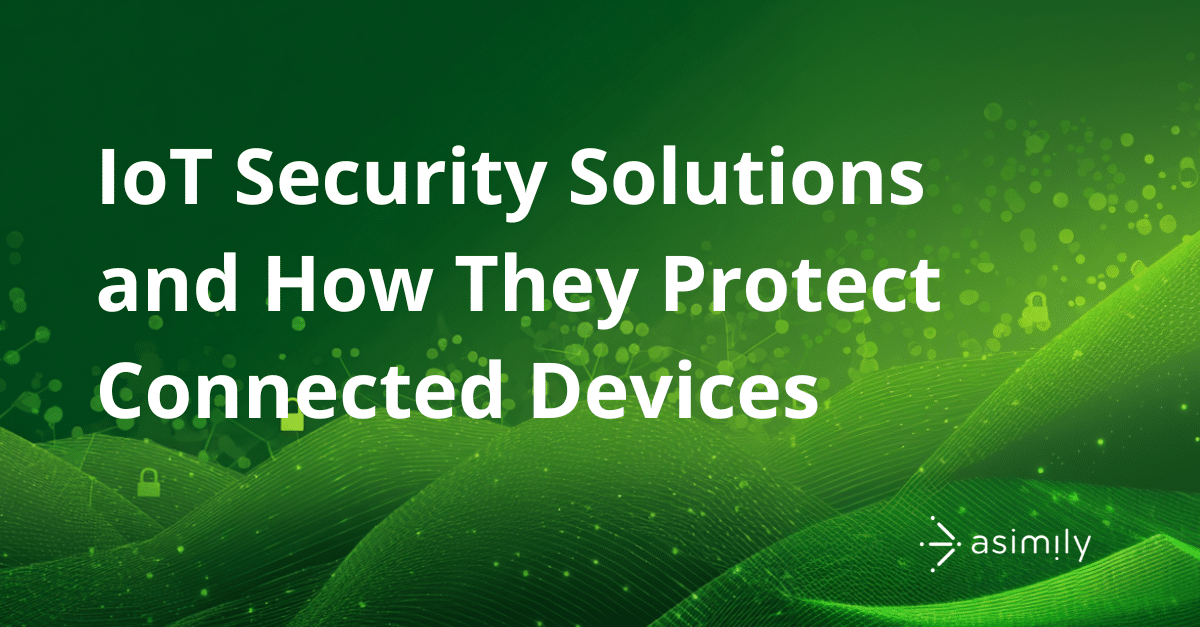IoT Security Solutions and How They Protect Connected Devices

Internet of Things (IoT) devices have become part of our everyday routines, reshaping how we live and work. However, this rapid growth has opened the door to new cyber threats. If compromised, these devices can serve as entry points for cybercriminals to gain access to other critical systems and sensitive data, which means businesses must implement robust security strategies.
An IoT security solution is an integral part of a robust security strategy. These solutions are designed to mitigate device risk and protect the broader network. A purpose-built security solution enables organizations to mitigate the risk associated with data breaches, business interruptions, and other fast-moving cyber threats.
Understanding IoT Security
The rapid adoption of connected technologies has transformed industries of all sizes, enhancing efficiency and delivering significant operational and cost benefits. As a result, billions of IoT devices are now in use worldwide, with some estimates projecting around 75 billion devices by 2025. The potential economic value unlocked by this expansion is enormous: by 2030, McKinsey estimates IoT could generate $5.5 trillion to $12.6 trillion globally.
However, despite these advantages, IoT has also introduced complex cybersecurity challenges that demand continuous vigilance. As deployments continue to grow, IoT ecosystems have become attractive targets for cyber threats, necessitating an integrated security strategy. A vulnerable device can easily serve as an attack vector, allowing opportunistic threat actors to gain a foothold within the network. That’s why an effective security strategy is essential to safeguard both devices and the broader systems they connect to.
Why is IoT Security Important?
The interconnected nature of IoT ecosystems means that a single vulnerability could impact multiple systems and operations. Industries that heavily rely on these devices, such as healthcare and manufacturing, are particularly vulnerable to security risks. For example, a security breach at a hospital could have serious ramifications, potentially exposing sensitive patient data or disrupting life-saving care due to device or system outages.
Many IoT devices lack standardized security features and have limited processing capabilities, making it difficult to apply the same controls used to protect traditional IT assets. Further complicating matters, many IoT devices cannot be scanned by traditional tools, which creates challenges in inventorying, patching, and hardening them.
IoT Security Solution Standards and Frameworks
Standards and frameworks play a critical role in securing the IoT. The National Institute of Standards and Technology (NIST) IoT Security Framework provides guidelines for securing devices, with a focus on access control and data protection.
Additionally, NIST’s framework for Improving Critical Infrastructure Cybersecurity outlines best practices for managing cybersecurity risks. This framework is adaptable, making it suitable for various sectors and organizations. Here are the five core functions of the NIST Framework:
- Identify – Understand and manage cybersecurity risks.
- Protect – Develop security controls to guard against threats.
- Detect – Implement systems for timely threat detection.
- Respond – Have plans in place to mitigate the impact of incidents.
- Recover – Establish measures to restore normal operations.
Common Security Risks of IoT
Understanding the most common threats and vulnerabilities is the first step toward building a stronger defense for IoT ecosystems.
- Expanded Attack Surface: IoT devices expand an organization’s attack surface, creating an attractive target for malicious actors. Organizations that store sensitive information or provide critical services such as healthcare, energy and utilities, and manufacturing are especially prime targets.
- Lack of Encryption: Unencrypted traffic puts sensitive information at risk. The absence of standardized encryption protocols contributes to increased security risks and complications in securing device communications.
- Insecure Protocols: Many devices use proprietary protocols that lack robust security, making them targets for stealthy man-in-the-middle (MitM) attacks.
- Outdated firmware: Devices running unpatched or outdated firmware are easy targets for attackers leveraging known exploits, emphasizing the need for consistent update and patch cycles.
- Weak or hardcoded credentials: Many devices ship with default, weak, or hardcoded passwords, making them susceptible to brute-force attacks and automated malware campaigns.
Lessons Learned: The Mirai Botnet and Verkada Camera Hack
Once compromised, devices can be hijacked and enlisted into botnets to launch powerful distributed denial-of-service (DDoS) attacks. Already, there have been several notable incidents that highlight just how vulnerable IoT ecosystems can be.
The 2016 Mirai botnet exploited default credentials on devices such as cameras and routers, turning them into a global botnet used to launch massive DDoS attacks on DNS provider Dyn, which in turn disrupted access to many popular websites.
Years later, in 2021, the hack of 15,000 Verkada cameras exposed weaknesses in cloud-managed security camera systems, granting attackers access to live feeds from hospitals, prisons, and offices.
These incidents underscore the urgent need for stronger security practices, including changing default passwords, enforcing least privilege, and regularly updating software to defend against evolving cyber threats.
Challenges in Securing IoT Devices
While IoT offers undeniable advantages, securing these devices introduces unique obstacles that differ sharply from protecting standard IT assets. From limited device capabilities to inconsistent update processes, these challenges demand a tailored approach.
Memory and Processing Power Limitations
Devices often have memory and processing power limitations that restrict their capacity to support advanced cybersecurity features like real-time threat detection. As a result, devices cannot perform robust encryption, extensive logging, or security analytics. The limited computational resources hinder them from conducting security scans or responding to threats promptly. An inability to effectively use over-the-air updates can also leave them vulnerable to cyberattacks. Organizations must take into account these limitations when designing their cybersecurity strategies and should consider leveraging an IoT security solution to mitigate the risk.
Patching and Updating Difficulties
Maintaining up-to-date device security is challenging due to their diversity. Some devices don’t support updates at all, leaving them vulnerable to attacks through unpatched security issues. Even when updates are possible, the process can be complex and time-consuming. Regular patching is crucial for devices that can be updated, as it addresses known security vulnerabilities.
Core Security Strategies for IoT Devices
Whether it’s smart home gadgets or industrial sensors, protecting connected devices from cyber threats requires a robust, clearly defined security strategy. Because many devices lack the same safeguards as traditional IT assets, they are especially vulnerable to unauthorized access and can even serve as a foothold for malicious actors to gain access and then move laterally within the broader network. A comprehensive approach should include measures to protect both the devices and the data moving through any edge and cloud infrastructures.
Implement Robust Authentication Mechanisms
Robust authentication mechanisms are essential for safeguarding devices against unauthorized access and control, thereby minimizing security risks such as data breaches and privacy violations. In addition to updating any weak, default credentials on the device, organizations should consider leveraging an identity and access management (IAM) solution to secure management consoles and enable multi-factor authentication (MFA).
Effective Updating and Patching
Deploying firmware updates is essential to safeguard devices against cyberattacks. However, many IoT vendors fail to alert organizations that an update is available, and updates can be complex to apply, as many devices run on old, outdated operating systems.
Similar to firmware updates, many devices have critical vulnerabilities that malicious actors can exploit to gain unauthorized access. Finding a patch that is available can be a job in and of itself, and patching generally requires taking the device offline. Many industries have a low threshold for downtime, and may be reluctant to have a device that is heavily used be non-operational for several hours.
An IoT security solution can detect and help detect and deploy firmware updates and security patches for critical vulnerabilities. Furthermore, it can evaluate patches before they’re applied, so organizations can rest assured the patch won’t break the device.
Ongoing Monitoring and Threat Detection
Continuous monitoring and threat intelligence are integral to protecting IoT environments. Effective device monitoring is critical for organizations to maintain visibility over the security posture of their connected device ecosystem. Security teams need to know how many devices are on the network, what access each device has, and how they communicate with other devices. In general, devices should behave in well-understood ways and only communicate with approved devices or services. An IoT security solution can provide teams with enhanced visibility, allowing them to easily identify anomalous device behavior and proactively respond to potential threats in real time.
Network Segmentation
Segmentation techniques play a pivotal role in enhancing device security. Implementing targeted network segmentation and leveraging machine learning to identify anomalies can make it easier to spot indicators of lateral movement early on. This way, if a malicious actor gains access to your device network, you can take immediate proactive steps to limit their ability to move around. Using targeted segmentation to divide your device network into smaller networks limits the exposure to potential threats and makes securing IoT devices easier based on exploit vectors.
What Makes the Best IoT Security Solution?
IoT boosts efficiency but also brings new cyber risks. A strong security strategy combines device visibility, patching and updating, and continuous threat detection to mitigate risk for all devices on the network. When organizations deploy a comprehensive IoT security solution, they gain enhanced device visibility, can harden devices against dynamic threats, and mitigate the risk of unauthorized access.
A good security strategy begins with a comprehensive device inventory, enabling organizations to accurately assess the number of connected devices on their network and engage in end-to-end risk management activities. Because normal security tools can’t scan these devices they can be challenging to inventory. A robust security solution automatically identifies all devices on the network and maintains an up-to-date device inventory with details such as device time, manufacturer, and firmware version.
Under normal circumstances, the patch and update process is cumbersome. Sometimes, there is a mandatory, multi-step update process, such as first updating to an older version before updating to the most current version. An IoT security solution helps organizations automate the patching and update process, reducing the risk of IoT-related security incidents and maintaining the integrity of their environment.
A robust security platform can further enhance device security with more advanced security mechanisms, such as automated IoT patching and targeted network segmentation.
Asimily: Security That’s More Than Just Protection
As organizations continue to deploy more connected devices and expand their attack surfaces, a robust security strategy becomes essential. By partnering with a security vendor that offers purpose-built IoT security software for monitoring and management, organizations can enhance their security and risk mitigation strategies, thereby reducing the likelihood of compromise and improving operational resilience.
The Asimily platform is designed expressly with IoT risk mitigation in mind. We offer organizations the depth and breadth of capability needed to secure all devices on your network under one platform.
With Asimily, security teams gain better insight into all assets connected to their systems. They can use this information to make proactive risk mitigation and management decisions that ensure uptime and create a stronger security posture.
Interested in learning more? Check out our platform overview.
Secure Every IoT Device.
Automatically.
Cyber threats move fast — so should you. Asimily gives instant inventory and smart, prioritized risk mitigation insights for every IoT, OT, and IoMT device — so you can take action before threats strike.




